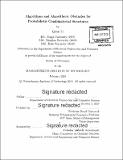Algorithms and algorithmic obstacles for probabilistic combinatorial structures
Author(s)
Li, Quan, Ph. D. Massachusetts Institute of Technology
DownloadFull printable version (10.58Mb)
Other Contributors
Massachusetts Institute of Technology. Department of Electrical Engineering and Computer Science.
Advisor
David Gamarnik.
Terms of use
Metadata
Show full item recordAbstract
We study efficient average-case (approximation) algorithms for combinatorial optimization problems, as well as explore the algorithmic obstacles for a variety of discrete optimization problems arising in the theory of random graphs, statistics and machine learning. In particular, we consider the average-case optimization for three NP-hard combinatorial optimization problems: Large Submatrix Selection, Maximum Cut (Max-Cut) of a graph and Matrix Completion. The Large Submatrix Selection problem is to find a k x k submatrix of an n x n matrix with i.i.d. standard Gaussian entries, which has the largest average entry. It was shown in [13] using non-constructive methods that the largest average value of a k x k submatrix is 2(1 + o(1) [square root] log n/k with high probability (w.h.p.) when k = O(log n/ log log n). We show that a natural greedy algorithm called Largest Average Submatrix LAS produces a submatrix with average value (1+ o(1)) [square root] 2 log n/k w.h.p. when k is constant and n grows, namely approximately [square root] 2 smaller. Then by drawing an analogy with the problem of finding cliques in random graphs, we propose a simple greedy algorithm which produces a k x k matrix with asymptotically the same average value (1+o(1) [square root] 2log n/k w.h.p., for k = o(log n). Since the maximum clique problem is a special case of the largest submatrix problem and the greedy algorithm is the best known algorithm for finding cliques in random graphs, it is tempting to believe that beating the factor [square root] 2 performance gap suffered by both algorithms might be very challenging. Surprisingly, we show the existence of a very simple algorithm which produces a k x k matrix with average value (1 + o[subscript]k(1) + o(1))(4/3) [square root] 2log n/k for k = o((log n)¹.⁵), that is, with asymptotic factor 4/3 when k grows. To get an insight into the algorithmic hardness of this problem, and motivated by methods originating in the theory of spin glasses, we conduct the so-called expected overlap analysis of matrices with average value asymptotically (1 + o(1))[alpha][square root] 2 log n/k for a fixed value [alpha] [epsilon] [1, fixed value a E [1, [square root]2]. The overlap corresponds to the number of common rows and common columns for pairs of matrices achieving this value. We discover numerically an intriguing phase transition at [alpha]* [delta]= 5[square root]2/(3[square root]3) ~~ 1.3608.. [epsilon] [4/3, [square root]2]: when [alpha] < [alpha]* the space of overlaps is a continuous subset of [0, 1]², whereas [alpha] = [alpha]* marks the onset of discontinuity, and as a result the model exhibits the Overlap Gap Property (OGP) when [alpha] > [alpha]*, appropriately defined. We conjecture that OGP observed for [alpha] > [alpha]* also marks the onset of the algorithmic hardness - no polynomial time algorithm exists for finding matrices with average value at least (1+o(1)[alpha][square root]2log n/k, when [alpha] > [alpha]* and k is a growing function of n. Finding a maximum cut of a graph is a well-known canonical NP-hard problem. We consider the problem of estimating the size of a maximum cut in a random Erdős-Rényi graph on n nodes and [cn] edges. We establish that the size of the maximum cut normalized by the number of nodes belongs to the interval [c/2 + 0.47523[square root]c,c/2 + 0.55909[square root]c] w.h.p. as n increases, for all sufficiently large c. We observe that every maximum size cut satisfies a certain local optimality property, and we compute the expected number of cuts with a given value satisfying this local optimality property. Estimating this expectation amounts to solving a rather involved multi-dimensional large deviations problem. We solve this underlying large deviation problem asymptotically as c increases and use it to obtain an improved upper bound on the Max-Cut value. The lower bound is obtained by application of the second moment method, coupled with the same local optimality constraint, and is shown to work up to the stated lower bound value c/2 + 0.47523[square root]c. We also obtain an improved lower bound of 1.36000n on the Max-Cut for the random cubic graph or any cubic graph with large girth, improving the previous best bound of 1.33773n. Matrix Completion is the problem of reconstructing a rank-k n x n matrix M from a sampling of its entries. We propose a new matrix completion algorithm using a novel sampling scheme based on a union of independent sparse random regular bipartite graphs. We show that under a certain incoherence assumption on M and for the case when both the rank and the condition number of M are bounded, w.h.p. our algorithm recovers an [epsilon]-approximation of M in terms of the Frobenius norm using O(nlog² (1/[epsilon])) samples and in linear time O(nlog² (1/[epsilon])). This provides the best known bounds both on the sample complexity and computational cost for reconstructing (approximately) an unknown low-rank matrix. The novelty of our algorithm is two new steps of thresholding singular values and rescaling singular vectors in the application of the "vanilla" alternating minimization algorithm. The structure of sparse random regular graphs is used heavily for controlling the impact of these regularization steps.
Description
Thesis: Ph. D., Massachusetts Institute of Technology, Department of Electrical Engineering and Computer Science, 2018. Cataloged from PDF version of thesis. Includes bibliographical references (pages 209-214).
Date issued
2018Department
Massachusetts Institute of Technology. Department of Electrical Engineering and Computer SciencePublisher
Massachusetts Institute of Technology
Keywords
Electrical Engineering and Computer Science.